Eighty percent of dentists, dental hygienists, and dental assistants report neck and shoulder pain every year—and often end the day wondering—"What are the best stretches for dentists that can help me get through this busy week?” And it’s not just head and neck stretches—dentists and dental professionals also have worry about the inherent hand and wrist fatigue that often comes with the job. If left uncared for and unaddressed, these chronic issues can grow from a small nuisance to a real pain in the neck—pun intended—sometimes leading to surgery and even disability or early retirement. But fear not—whether you’re looking for the right head and neck exercises for dentists, or you’re a dentist, assistant, or hygienist looking to ease back, wrist, and hand pain (click here for tips!), we have you covered.
According to Dr. Bethany Valachi—the premiere researcher on the neck and shoulder pain dentists and dental professionals often experience—even when clinicians and hygienists are seated with perfect posture, more than half of the muscles in the body are in a state of sustained contraction.
The good news is that with stretching and targeted exercise, dentists, hygienists, and dental assistants can prevent these injuries before they become debilitating—the key is vigilance and consistency.
Here at Ultradent, we have plenty of dentists and dental hygienists who bring years of experience to the table, and today, Hartley Lojik—one of Ultradent’s seasoned on-staff Registered Dental Hygienists and fitness/yoga enthusiasts—is here to share her tips for how she keeps herself and her staff—including the dentist—pain and tension free through the neck and shoulders, even after long days in the dental operatory!
Tip #1: USE YOUR LOUPES!
“As a dental hygienist that regularly works alongside dentists, I see a great pair of loupes as essential for both of us. Without them, we’d be bending our necks and straining, when the loupes allow you to simply lower your chin a bit and see everything you need to see in the patient’s mouth,” Lojik says. “If your loupes angle downward, that’s going to save dentists and hygienists a lot of future shoulder and neck pain because they won’t be straining.”


Wearing loupes, dental hygienists and dentists don’t have to strain and bend their neck forward, thanks to the declination angle that most good dental loupes offer, as demonstrated between the photo (left), where Hartley is wearing loupes, and the photo (right), without loupes.
She’s backed by Dr. Valachi, who says that consistently leaning the neck forward more than 20% is “significantly associated with neck pain,” and suggests that all dentists and even hygienists, if they’re experiencing pain or discomfort, invest in a great pair of loupes. Loupes with a good declination angle are even better.
Tip #2: Upper Trapezius Stretch
This simple stretch can help ease a myriad of pain, aches, and tension that often builds up in the neck and shoulders of dentists, dental hygienists, and dental assistants. It’s important to practice it daily or any time rigidity and strain set in during the workday in the dental operatory. It’s also a great stretch to begin the day with.

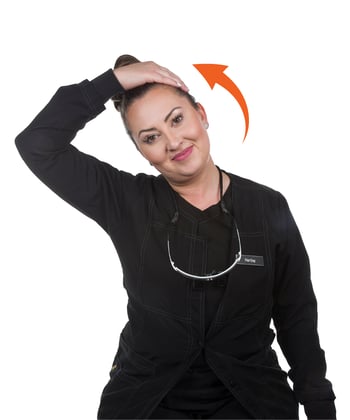
Begin by tilting your head toward your right shoulder while ensuring your left shoulder remains down. Hold this position for three to five seconds. Then tilt your head to the left shoulder while keeping your right shoulder still.
Tip #3: Chin Tuck Stretch
“I love this stretch because it really gets rid of some of that tension that I often don’t even know I’m carrying at the base of my neck after a long day in the operatory. I like to do this stretch with the dentist and dental assistants before and after a workday to keep things loose and keep our neck relaxed. If you really hold the chin tuck, you’ll notice some tension release in the shoulders as well, which is nice,” says Lojik of the exercise.

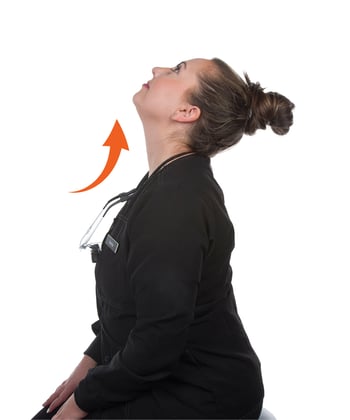
Sit straight, with shoulders back and down. Tuck your chin and hold for one to two seconds. Then stretch neck back, pointing face at the sky. Repeat as often as needed.
The Chin Tuck helps keep the neck in proper alignment as well as relieving shoulder and scapular muscle pain. That unreachable knot between the shoulder blades is usually caused by forward neck posture, which is unavoidable even with loupes (especially during times of intense focus and instrumentation during challenging periodontal cases). This simple exercise should be done every day as much as possible for a healthy neck.
Tip #4: Wingspan Stretch/Upper Cowface Pose
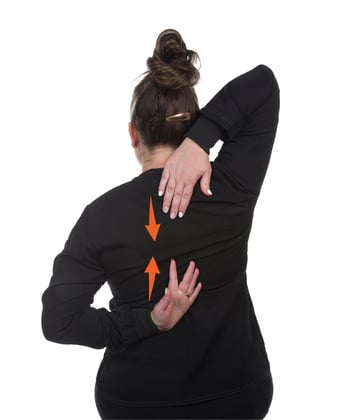
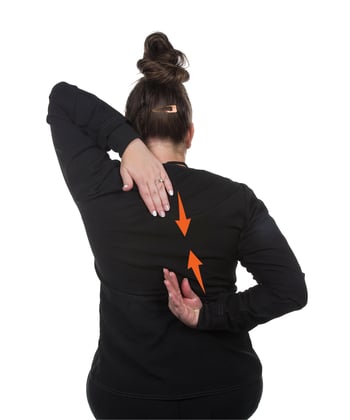
If you can’t link hands together at first, any reach will still help open release shoulder tension and open up the chest.
Though more difficult, this stretch increases shoulder elasticity, relaxing stiffness that may have built up during the day. It also opens up the chest and improves posture and flexibility. If you find it difficult to clasp your hands together behind your back, reach as far as you can comfortably go while giving your muscles a reasonable stretch. With time, you should see flexibility improvement. Another great hack for achieving this stretch is to hold on to either end of a small towel behind your back and, with each arm, pull slightly on one end of the towel at a time to improve range of motion. Then, repeat the stretch, switching the position of each arm from above to below.
Tip #5: Cross-Body Shoulder Stretch
The cross-body shoulder stretch creates a great stretch for the posterior shoulder, helping to increase mobility, improve posture, and prevent future injury, strain, and soreness. “This is one of the first stretches I learned in dental hygiene school,” says Lojik. “Any time I’m going to work all day in the dental operatory, I begin and end with this stretch. It feels amazing.”

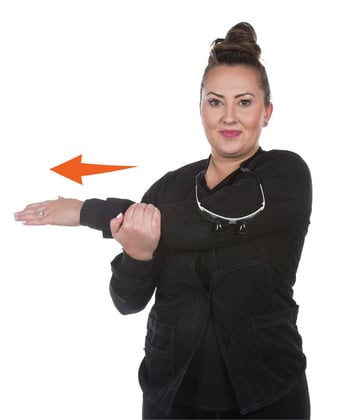
In a standing position, take one arm and place it horizontally across chest. Using your other hand, grab the outer forearm of the arm that’s positioned across the body and push to give it more of a stretch. Hold for thirty seconds and repeat with the opposite arm.
Tip #6: Simple Shoulder Rolls
Shoulder rolls are an easy, efficient, and effective way to relieve built-up tension in the shoulders and improve circulation to the neck and shoulder joints. It’s also a great exercise to begin and end the day with, or to shake out stress when you notice you’re needlessly shrugging your shoulders—a sure sign of strain.

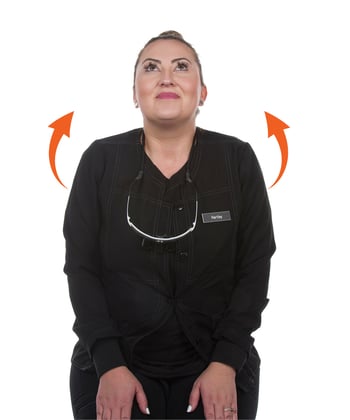
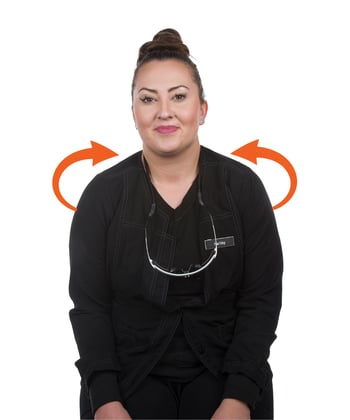
Shoulder rolls can be done from either a sitting or standing position. Begin by taking a deep breath and raising your shoulders toward your ears, one at a time. Then exhale and lower your shoulder down toward your back. Hold for threeseconds and repeat this stretch five to eight times.
Tip #7: Sitting Thoracic and Lat Stretch
This stretch can be done sitting right at your desk and is an easy way to relieve upper back and neck pain—which is the most common area where dentists, dental hygienists, and dental assistants experience chronic discomfort.
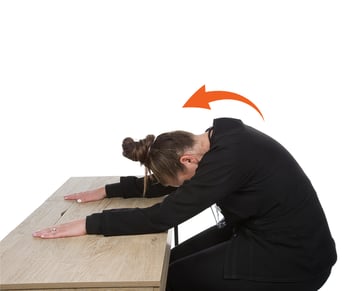

Place your arms up on a desk about shoulder-width apart while sitting on a chair. Make sure you are back far enough that you have room to lean forward and over and drop your head between your elbows. Then with your arms on the desk, relax your chest and lean your head over, sitting your butt back just slightly. Press your chest toward the desk, arching your head back, and feel a nice stretch down your triceps and lats as well as through your thoracic spine. Try to extend your back as much as possible as you press your chest toward the desk.
Bonus Tips:
Other tricks of the trade, like buying a supportive ergonomic pillow to sleep on at night, making sure your patient isn’t positioned too high or too low, using arm rest supports, getting regular exercise, and lowering the stress in your life through activities such as meditation and deep breathing will all contribute positively to the longevity and health of your neck and shoulders, as well as your dental career. After all, you’ve sacrificed too much and come too far to suffer a needless injury or chronic neck and shoulder pain that too many dentists and dental professionals experience.
Here's to many years of health and happy muscles and joints, and here’s to you—the people who keep us smiling bright.








